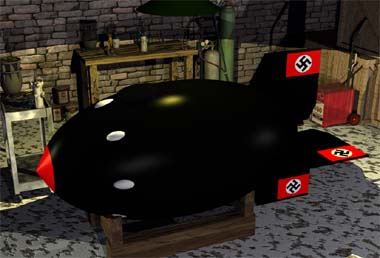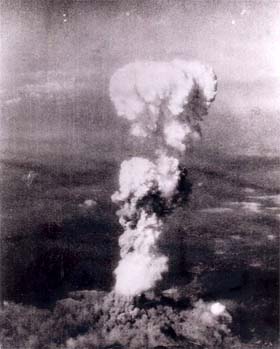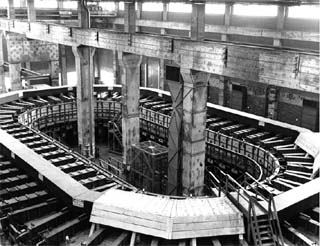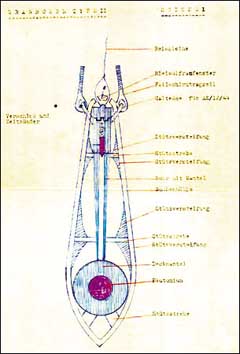Did
the Nazis Build an Atomic Bomb?
|

In
some secret, hidden laboratory did scientists build an atomic
bomb for Hitler? (Copyright Lee Krystek,
2007)
|
For years historians had argued that the Nazi effort
to build an atomic bomb during World War II was far behind that
of the Allies. Then in a controversial 2005 book, historian Rainer
Karlsch made a startling claim…
On March 4, 1945, Clare Werner was standing on
a hillside in Thuringian, Germany. Not too far away was the military
training base near the town of Ohrdruf. Unexpectedly there was
a flash of light. "I suddenly saw something," she said, " ...
it was as bright as hundreds of bolts of lightning, red on the
inside and yellow on the outside, so bright you could've read
the newspaper. It all happened so quickly, and then we couldn't
see anything at all. We just noticed there was a powerful wind..."
In the days that followed Werner complained of nose
bleeds, headaches and pressure in her ears. Was what she witnessed
the test of a nuclear weapon by Nazi scientists? How close did
Hitler come to having a working atomic bomb?
Discovery
of Fission
In 1938, two Germans, Otto Hahn and Fritz Strassmann,
working at the Kaiser Wilhelm Institute in Berlin, discovered
that when they bombarded uranium with neutrons they could split
the uranium atoms' nuclei into two parts releasing energy and
more neutrons (a process called fission.) From this it was obvious
to scientists around the world that it was possible to create
energy-producing fission chain reactions as the neutrons from
one split-atom plowed into surrounding atoms, splitting them also.
A controlled chain reaction could be used for constructive purposes
like making heat that could be used to produce electricity. An
uncontrolled chain reaction, however, would be a bomb of incalculable
power.
As World War II appeared on the horizon, scientists
in the United States, Germany and other nations, approached their
governments, warning them of these developments. At the time the
state of physics research in each country was roughly on par.
If this was the case, how come United States and its allies went
on to develop the atomic bomb and Germany didn't?
Incompetence,
Conspiracy, or Neither?
In the half-century following the war, several theories
arose to explain the lack of German success. Samuel Goudsmit,
a member of the Allied scientific intelligence mission that investigated
German progress on a bomb, came to the conclusion that the German
scientists working on the project simply didn't have the understanding
necessary to build such a weapon. In other words, Goudsmit claimed
that these scientists, all approved to work on the project by
the Nazi government, were simply incompetent.
|

German
physicists were surprised by the Allies atomic bomb dropped
on Hiroshima.
|
His thinking may have some support in recordings
made in 1945. After Germany surrendered, German physicists involved
in uranium research were rounded up and detained at Farm Hall
in England. Their conversations were secretly recorded in hopes
of finding the state of Nazi research in physics. Of tremendous
interest to the British was the scientists' reaction to the news
that the Allies had dropped an atomic bomb on Hiroshima. Werner
Heisenberg, the head of the German program at Kaiser Wilhelm Institute,
was initially amazed at the success of the Allies program. He
immediately tackled the question of how much uranium 235 (the
only isotope of uranium which would work as a nuclear explosive)
would be needed to build a bomb and came up with a figure of over
a ton - way too high. It is from this mistake that many experts
have formed the opinion that Heisenberg did not really understand
how a bomb would work. However, Heisenberg corrected his estimate
within a few days. Also, comments by Otto Hahn, who was another
scientist interned at Farm Hall, suggests that Heisenberg had
earlier, back in Germany, made the correct calculations. Perhaps
he was now hiding his knowledge thinking that he and the other
scientists were under surveillance, which indeed, they were.
As additional evidence of the German lack of understanding,
Goudsmit argued that the Germans did not appreciate that the element
plutonium could also be used to fuel a bomb. Documents recently
found in Russian archives, however, clearly show this idea to
be false. In 1941, Von Weizsäcker, a colleague of Heisenberg,
wrote about plutonium in a patent application, "With regard to
energy per unit weight this explosive [plutonium] would be around
ten million times greater than any other [existing explosive]
and comparable only to pure uranium 235."
Another popular theory is that Heisenberg actually
sabotaged the German atomic bomb program because he didn't
want Hitler to win the war. This idea originally was presented
in a 1958 book by Robert Jungk called Brighter Than a Thousand
Suns: A Personal History of the Atomic Scientists. Heisenberg
did nothing to dissuade Jungk of this idea and later hinted that
in a now famous September 1941 meeting with his old mentor, Niels
Bohr, he had suggested that he was willing to join an agreement
among all physicists to deny these powerful new weapons to all
governments. This assertion is echoed in Thomas Power's book Heisenberg's
War and Michael Frayn's play Copenhagen. Niels Bohr
never publicly spoke of the meeting, but papers found after his
death tell a different story: Heisenberg was willing to work with
the Nazis and wanted Bohr to join him.
The real reason that the German effort was not successful,
however, probably had nothing to do with either a conspiracy by
scientists to withhold the weapon or a miscalculation by Heisenberg
in building one. Early in 1942, German Army Ordnance completed
a report which ranked weapons programs by how promising they were.
Based on the information available at the time, it seemed unlikely
that a nuclear bomb could be developed in less than two years.
The German belief that the war would be over in two years steered
the Army to only invest in weapons programs that could be completed
within that period.
It is unknown if Heisenberg himself made this time
estimate, but it appears to be scientifically accurate and consistent
with predictions made by Allied scientists. The Allies, however,
concerned that the war would go much longer than two years, and
that the Germans might be able to produce their own nuclear weapon,
invested heavily in building such a device. Ironically, unknown
to the Allies, the German program had been put on the back burner
and was not a real threat.
An
Industrial Project
|

One
of the many calutrons at Oak Ridge used for creating the
enriched uranium for atomic bombs. Germany would not have
had sufficient resources for such a large industrial effort
during the war.
|
Even if the Third Reich had decided to build an
atomic bomb, it might have been beyond German means. The Allies'
Manhattan Project, which created their nuclear weapons,
was just as much of an industrial effort as a scientific breakthrough.
The project cost the equivalent of $30 billion in today's dollars
and employed 125,000 people. Vast amounts of complex machinery
and sprawling factories were needed to turn out the rare uranium
235 and plutonium necessary to fuel the bombs. Germany just didn't
have the industrial capacity to support such an undertaking during
the last years of the war.
Even if they had attempted it they would have found
their factories exposed to constant Allied bombing attacks. The
Allies, on the other hand, could place their project facilities
deep in the heart of North America (in places like New Mexico
and Tennessee) far from observation and interference by the Axis
powers. So it appears there was really little chance of the Nazis
actually developing an atom bomb during the war. They didn't even
come close… or did they?
Karlsch's
Zombie Bomb
German historian Rainer Karlsch, thinking about
these issues wrote, "It would be rash indeed to believe that this
is the last word on the matter. The German atomic bomb is like
a zombie: just when we think we know what happened, how and why,
it rises again from the dead." Karlsch resurrected the latest
zombie himself when his book, Hitler's Bombe, was released
in 2005. The book presents evidence that a second team of scientists
under the direction of army physicist Kurt Diebner was much more
oriented toward a weapons program than the Heisenberg group and
had more success. Karlsch contends that this group was designing
a bomb that used both nuclear fission and fusion (like that in
an H-bomb) principles to release energy. He further suggests that
this type of device was tested three times shortly before the
end of World War II. One test occurred on the German island of
Ruegen in the fall of 1944 and two more in the eastern state of
Thuringia in March of 1945. While Karlsch doesn't say that the
tests were entirely successful, he does believe that 700 people
(mainly prisoners) died in the blasts.
|

Karlsch
found a sketch made by an unknown German scientist that
looks like a diagram for an atomic bomb.
|
After the publication of his book, Karlsch also
found portions of a document written just after World War II by
an unknown German scientist. A diagram found in these notes shows
a sketch of a nuclear device very similar to the one Karlsch thinks
was tested. Physicists that have examined the diagram don't believe
it would actually have been capable of functioning, but Karlsch
argues that the success of the weapon isn't the point. "…what
is important," he writes in an article in PhysicsWeb with
co-author Mark Walker, "is the revelation that a small group of
scientists working in the last desperate months of the war were
trying to do this."
Dirty
Bomb
Another piece of evidence Karlsch points to is a
Russian report written by Soviet spies. The report warns the Soviet
leader, Stalin, that the Germans "detonated two large explosions
in Thuringia." According to the report, these bombs probably contained
uranium 235 and produced a "highly radioactive effect." The report
goes on to say that prisoners of war housed at the location were
killed, "and in many cases their bodies were completely destroyed."
Critics of Karlsch's work cite inconsistencies in
his theory. For example, the bomb the Soviet report describes
is not really a nuclear weapon because it does not use radioactive
material to fuel the blast. It was, what would be called today,
a "dirty bomb:" a conventional weapon laced with dangerous radioactive
material to poison the surrounding area. This does not fit with
the description made by Clare Werner of the test at Thuringia,
which sounds more like a true atomic blast. Almost all parties
agree, however, that Germany at that time did not have either
the necessary uranium 235 or plutonium to build a true atomic
bomb that could create such a fireball.
In February, 2006, scientists from Physikalisch-Technische
Bundesanstalt in Germany traveled to Thuringia and took samples
of soil to see if there was evidence there of any kind of a nuclear
blast. Their reported revealed no abnormal background levels of
radiation, other than those elevated as a result of the Russian
Chernobyl reactor accident in 1986. Still, the report emphasizes
that the tests do not disprove that there was an atomic blast
at that location. It simply shows that there is no evidence in
the soil to to support such a claim.
Even if you doubt Karlsch's theory, however, there
is one area where you must agree with him: we have not heard the
last word on this subject. There appears there is still some room
left in the mists of history for the Nazi atomic bomb to rise
from the grave at least one more time.
A
Partial Bibliography
Nazi Science, by Mark Walker, Plenum Press,
1995.
Heisenberg and the Nazi Bomb Project, by
Paul Lawrence Rose, University of California Press, 1998.
New Light on Hitler's Bomb, by Rainer Karlsch
and Mark Walker, Physics Web, June 2005, http://physicsweb.org/articles/world/18/6/3l
Hitler's Bombe, Wikipedia, September
2006, http://en.wikipedia.org/wiki/Hitlers_Bombe

Copyright Lee Krystek
2007. All Rights Reserved.